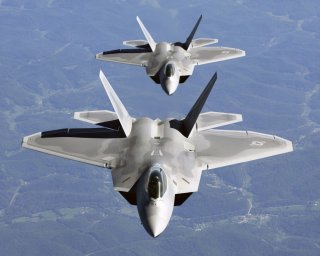'Invisible': Former F-15 Pilot Explains What Makes the F-22 Raptor a Killer
As the world’s first-ever fifth-generation platform, the F-22 has legendary connotations. The stealthier, faster, and more maneuverable fighter platform has wowed industry experts and aviation buffs alike since it entered service with the Air Force several decades ago.
As the world’s first-ever fifth-generation platform, the F-22 has legendary connotations. The stealthier, faster, and more maneuverable fighter platform has wowed industry experts and aviation buffs alike since it entered service with the Air Force several decades ago.
The workhorse of the service recently made headlines when U.S. Central Command (CENTCOM) deployed Raptors to the Middle East in response to Russia’s escalating provocations in the region. Although the F-35 Lightning II is newer and equipped with better technology, the Raptor continues to serve as a formidable deterrent to America’s adversaries across the globe.
A Brief History of the F-22 Raptor
During the later years of the Cold War, the Air Force first recognized the need to develop an air-superiority fighter in light of the Soviet Union’s advanced air defense systems.
Intended to replace the F-15 Eagle and F-16 Fighting Falcon, the new program would be designed to go head-to-head against the USSR’s Sukhoi Su-27 “Flanker” and Mikoyan MiG-29 “Fulcrum” fighter jets.
The Advanced Tactical Fighter (ATF) would have to sport cutting-edge avionics and technologies in order to perform both offensive and defensive counter-air operations in a highly contested environment. For this reason, the service turned to the aerospace industry for help. Ultimately, seven bidding teams worked collaboratively on two demonstration prototypes, and Lockheed Martin and Pratt & Whitney were selected as winners. The F-22 took its first flight in the late 1990s and officially entered service with the Air Force by 2005.
Perhaps the most important aspect of the Raptor platform is its supermaneuverable flight characteristics. The fighter’s smaller radar cross-section and twin thrust-vectoring F119 turbofan engines enable the jet to fly undetected by enemy airframes and outclass near-peers in a dogfight. Additionally, the Raptor’s advanced sensor suite allows its pilot to detect, identify, and take down air-to-air threats prior to being detected. The F-22 also packs quite the punch ordnance-wise. In the air-to-air configuration, the F-22 can carry half a dozen AIM-120 AMRAAMS and two AIM-9 Sidewinders.
What a Former Eagle Pilot Has to Say About the Raptor
The Raptor is highly respected among aviation buffs, especially those who have actually been able to pilot the fighter. One former aviator even said that comparing the Raptor to its predecessors like the F-15 Eagle is “like having two Football Teams against each other and one of them [the Raptor] is invisible.”
In an interview with the Aviation Geek Club, former USAF pilot Mike ‘Dozer’ Shower described his experience flying the F-15 Eagle when the F-22 first entered into service:
“In an F-15 you’re sensor operator, you’re working the radar; you’re the guy working this all out and managing the systems and putting together the 3D picture in your head. That’s the difference with the F-22 Raptor. It does it all for you … you could take four weapons instructors in an F-15 each and you could have some lieutenant who is ‘weapons clueless’ and he’s gonna find them all and kill them all. Then you put one really good guy in an F-15 against a Raptor and he’s still gonna get killed; there’s that much of a difference in technology. It’s about sensors and training.”
Although the F-15 was the top-of-the-line jet an Air Force pilot could hope to operate for many years, the emergence of the Raptor really showcased its limitations.
Maya Carlin is an analyst with the Center for Security Policy and a former Anna Sobol Levy Fellow at IDC Herzliya in Israel. She has by-lines in many publications, including The National Interest, Jerusalem Post, and Times of Israel. You can follow her on Twitter: @MayaCarlin.
Image: Creative Commons.

